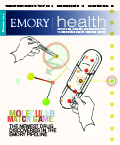A vaccine for all flu seasons
|
Emory researchers are seeking the ultimate, all-encompassing, super hero flu vaccine—a single flu shot that would provide such broad, lasting immunity that annual shots would no longer be necessary. |
Because of the high variability of flu viruses, every year scientists must develop new vaccines that are specifically oriented to combat the strain that appears likely to circulate that year. But what if a vaccine with super hero qualities could be created which protects from a host of influenza strains and lasts far longer than one flu season?
Thanks to an unexpected immune response to the 2009 H1N1 pandemic flu strain, the concept of a universal flu vaccine is now a strong possibility, says Rafi Ahmed, director of the Emory Vaccine Center and a Georgia Research Alliance Eminent Scholar.
In fact, Emory scientists currently are working on just such a groundbreaking vaccine. “We are learning from immune responses that are teaching us how to design vaccines in new ways, based on the information we got from these unexpected antibodies,” says Ahmed.
The surprising 2009 H1N1 findings resulted from a collaboration between the laboratories of Ahmed at Emory and researcher Patrick Wilson at the University of Chicago. Results of their study, recently published in the Journal of Experimental Medicine, showed that a group of patients who were infected with the 2009 H1N1 strain developed broadly protective antibodies against a variety of flu strains—including all the seasonal H1N1 flu strains from the past decade, the deadly “Spanish flu” strain from 1918, and the pathogenic H5N1 “bird flu.”
How did the 2009 H1N1 virus spur such a high proportion of antibodies? Ahmed thinks it’s because the 2009 H1N1 flu was so different from other varieties of flu.
The key involves influenza hemagglutinin (HA), a vital part of all flu virus “machinery.” Shaped like a mushroom with a “head” and stem-like region, HA is responsible for binding the virus to the cell that is being infected. While it is known that the HA stem region is broadly cross-reactive, the antibodies generated there normally don’t persist after an annual flu shot or after infection with a seasonal flu strain. But they did after the 2009 H1N1 infection.
“If the virus were related more to previous influenza strains, we would not be getting all these antibodies. The HA ‘head’ would be so similar to other influenza viruses, it would basically activate just those B cells and we would get those specific antibodies,” Ahmed explains. “Instead, a high proportion of broadly protective antibiodies were produced that reacted to the stem region of the HA.”
The antibodies were found to protect specifically against all the H1 influenza strains as well as the H5, or bird flu, strain. But they were ineffective against H3 influenzas. “There are regions of the HA stem which should with the right immunogen crossover and result in antibodies that protect also against H3,” Ahmed says. “ With the right immunogen that is common to all of the strains, I think it should be possible to generate these responses.”
That would result in an ultimate, all-encompassing flu vaccine—a single flu shot that would provide such broad, lasting immunity that annual shots would no longer be necessary. “It would transform the vaccine strategy that we have now,” says Ahmed.
At present, various research groups are working to design such a vaccine, using what has been learned from the 2009 H1N1 findings. Ahmed’s group is collaborating with investigators at Mt. Sinai Hospital on pre-clinical tests in mice of a “headless” vaccine using only the HA stem region of the flu virus. If the results are successful, the investigators will move to studies in nonhuman primates. Ahmed expects phase 1 clinical trials in humans to begin in approximately five years.
So while finding the ultimate super hero of flu shots remains in the future, it no longer seems elusive. “Our findings have given us a lot of hope and optimism toward the goal of an influenza virus vaccine which would protect against multiple strains,” Ahmed says.—Sherry Baker



